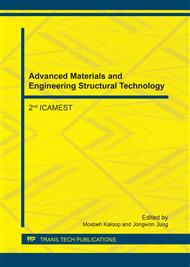[1]
F. Weng, C. Chen, H. Yu, Research status of laser cladding on titanium and its alloys: A review, Mater. Des. 58 (2014) 412-425.
DOI: 10.1016/j.matdes.2014.01.077
Google Scholar
[2]
C. Cui, et al., Titanium alloy production technology, market prospects and industry development, Mater. Des. 32(3) (2011) 1684-1691.
Google Scholar
[3]
L. M. Amoo, On the design and structural analysis of jet engine fan blade structures, Progress Aerosp. Sci. 60 (2013) 1-11.
DOI: 10.1016/j.paerosci.2012.08.002
Google Scholar
[4]
L. Jacobsen, P. Jablonski, N. Canfield, E. Low-Cost Titanium Evaluation, Automotive Lightweighting Materials, Technical Report, (2004) 83-86.
Google Scholar
[5]
M. Kutz, Mechanical Engineers' Handbook, Materials and Mechanical Design, Wiley, (2005).
Google Scholar
[6]
C. Leyens, M. Peters, Titanium and Titanium Alloys: Fundamentals and Applications, Wiley, (2006).
Google Scholar
[7]
B. Gunawarman, et al., Mechanical properties and microstructures of low cost β titanium alloys for healthcare applications, Mater. Sci. Eng. C, 25(3) (2005) 304-311.
DOI: 10.1016/j.msec.2004.12.015
Google Scholar
[8]
W. D. Callister, D. G. Rethwisch, Materials Science and Engineering: An Introduction. Eight ed, John Wiley & Sons, Inc, New Jersey, (2013).
Google Scholar
[9]
C. N. Elias, et al., Biomedical applications of titanium and its alloys, JOM, 60(3) (2008) 46-49.
Google Scholar
[10]
Q. Y. Wang, et al., Development and properties of Ti-In binary alloys as dental biomaterials, Mater. Sci. Eng. C, 33(3) (2013) 1601-1606.
Google Scholar
[11]
M. Chandrasekaran, Z. S. Xia, Effect of alloying time and composition on the mechanical properties of Ti alloy, Mater. Sci. Eng. A, 394(1-2) (2005) 220-228.
DOI: 10.1016/j.msea.2004.11.056
Google Scholar
[12]
R. R. Boyer, An overview on the use of titanium in the aerospace industry, Mater. Sci. Eng. A, 213(1-2) (1996) 103-114.
Google Scholar
[13]
Y. Q. Zhao, W. L. Wu, H. Chang, Research on microstructure and mechanical properties of a new α+Ti2Cu alloy after semi-solid deformation, Mater. Sci. Eng. A, 416(1-2) (2006) 181-186.
DOI: 10.1016/j.msea.2005.10.038
Google Scholar
[14]
F. H. S. Froes, M. Gungor, M. Ashraf Imam, Cost-affordable titanium: The component fabrication perspective, JOM, 59(6) (2007) 28-31.
DOI: 10.1007/s11837-007-0074-8
Google Scholar
[15]
F. Froes, D. Eylon, Developments in titanium P/M, ID: University of Idaho website, Moscow, (2005).
Google Scholar
[16]
E. Kraft, Opportunities for Low Cost Titanium in Reduced Fuel Consumption, Improved Emissions, and Enhanced Durability Heavy Duty Vehicles, ORNL Oak Ridge National Laboratory (US), (2002).
DOI: 10.2172/814648
Google Scholar
[17]
M. Ashraf Imam, F. H. S. Froes, TMS 2010 symposium: Cost-Affordable Titanium III, JOM, 62 (2010) 15-16.
DOI: 10.1007/s11837-010-0068-9
Google Scholar
[18]
G. Q. Shang, et al., Experimental Study on Heat Yreatment Processing of a New Low Cost Titanium Alloy Used in Aviation Field, Mater. Sci. Forum, 747-748 (2013) 919-925.
DOI: 10.4028/www.scientific.net/msf.747-748.919
Google Scholar
[19]
F. Hideki, T. Kazuhiro, Development of High Performance Ti-Fe-Al Alloy Series, Nippon steel technical report, Overseas, (2002) 113-117.
Google Scholar
[20]
H. Kadiri, et al., Development of a Ti-based alloy: Design and experiment, JOM, 61(5) (2009) 60-66.
Google Scholar
[21]
J. H. Seo, et al., Mechanical Characterization of Ti-Mo-Fe Titanium Alloy, Adv. Mater. Res. 567 (2012) 37-40.
Google Scholar
[22]
G. Wang, et al., Hot compressive behavior of Ti–3. 0Al–3. 7Cr–2. 0Fe–0. 1B titanium alloy, Trans. Nonferrous Metals Soc. China, 22(12) (2012) 2965-2971.
DOI: 10.1016/s1003-6326(11)61557-4
Google Scholar
[23]
V. A. Joshi, Titanium alloys: an atlas of structures and fracture features, CRC Press, (2006).
Google Scholar
[24]
P. G. Esteban, et al., Low-cost titanium alloys? Iron may hold the answers, Metal Powder Report, 63(4) (2008) 24-27.
DOI: 10.1016/s0026-0657(09)70040-2
Google Scholar
[25]
F. H. Froes, et al., Titanium in the family automobile: The cost challenge, JOM, 56(2) (2004) 40-44.
DOI: 10.1007/s11837-004-0144-0
Google Scholar


